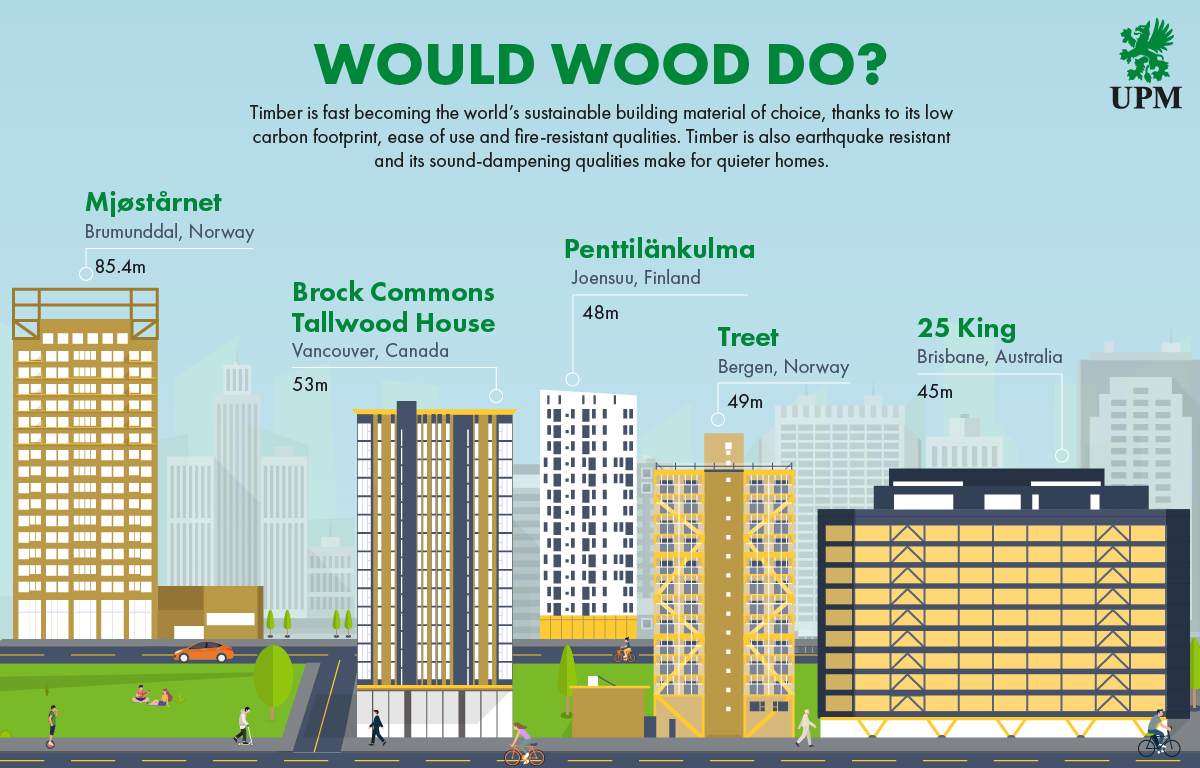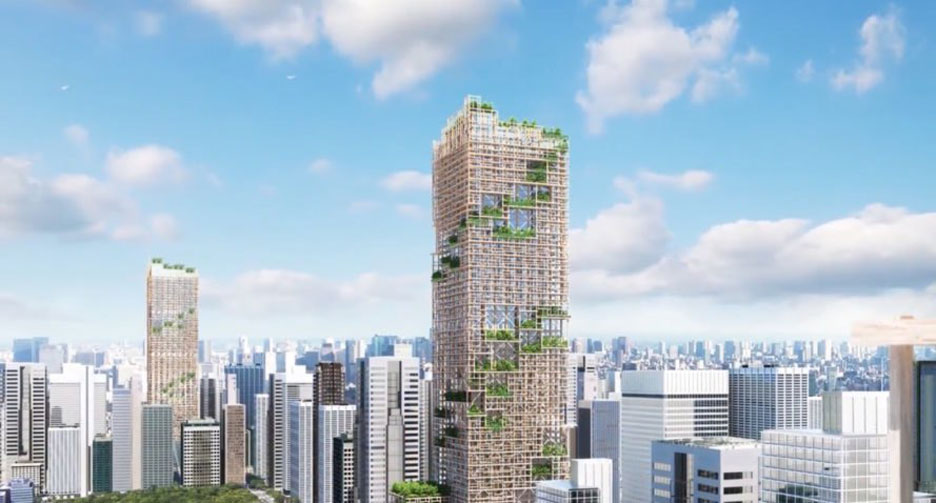New technologies are further enhancing the use cases for an already versatile building material – timber. With the number of wooden buildings around the world on the rise, we take stock of why the construction sector is betting on timber and other wood products to build truly sustainable buildings.

This autumn, as the university term begins in the Finnish city of Joensuu, students are returning from summer holidays and moving into newly built student accommodation. Their new home, the 14-storey high Lighthouse, is now the country’s tallest wooden multi-story building and the fourth highest in the world.
Unlike other timber buildings, such as Mjøstårnet in Norway and Brock Commons in Canada, the Lighthouse is in a league of its own as it has a supporting structure that is made solely of timber.
“Building with wood requires simultaneous restraint and imagination, in addition to a knack for working around red tape,” says Samuli Sallinen, CEO at the architecture firm Arcadia, which is behind the Lighthouse project.
The future of sustainable buildings?
There is a common misconception that using wood or timber to construct buildings is unsustainable, the reality is that timber buildings require fewer fossil fuels to produce and can effectively sequester carbon for years. Timber buildings can, if built correctly, retain more carbon than is released into the atmosphere throughout the process of planning, transporting and building the timber structure.
The amount of carbon a building can trap is called embodied carbon and is, according to Sallinen, likely to be specified in building regulations in the future in the same way as insulation and airflow are today. This will, in turn, increase the use of wood in buildings.
Considering other materials, the water and energy-intensive processes involved in producing concrete or steel can increase a building’s carbon footprint dramatically. According to the Yale School of Forestry & Environmental Studies, the manufacture of steel, concrete and brick accounts for about 16% of global fossil-fuel consumption.
“The difference between building with timber today and 30 years ago is that we now have new information about the climate that gives us a strong imperative to build sustainably,”
says Jeff Spiritos, Principal at Spiritos Properties LLC in New York City and member of the Council for Tall Buildings and Urban Habitat’s (CTBUH) Tall Timber Working Group.
It is even possible to achieve a negative carbon footprint by using responsibly sourced timber.
Strong, light and durable
Timber’s environment-friendly features are not the only reasons why it is fast becoming a crucial resource in the construction sector.
Engineered wood, such as cross-laminated timber (CLT), is strong and can have the same lifespan as materials used in conventional buildings. It is also fire resistant and light, potentially reducing the total weight of the building significantly.
Its lighter weight makes it ideal for building in earthquake-prone areas, and also in long-term urban planning as timber buildings can be dismantled and reused relatively easily, compared to brick and concrete.
Of course, unlike steel and concrete, timber elements need to be protected from water during the build. The building process for the Lighthouse project, for instance, involved a simple and cost-effective solution – a temporary roof was set up over the building and moved up as the building increased in height.
“We considered the need to work in dry conditions a minor issue. All materials have characteristics you need to consider, such as weight and drying time for concrete, and this was no different,” says Sallinen.
Vertical limits
So, what are the other challenges in constructing timber buildings? Surprisingly, one challenge is space. If you're working on a blueprint for a skyscraper such as the Oakwood Timber tower, expected to come in just shy of London’s highest building The Shard, the reality is that space is at a premium and a wooden structure requires a wider base.
“Working out what is possible, practical and within the rules of the building code is a challenge in itself,” explains Sallinen. “Until the Lighthouse project was approved, the number of stories allowed in a timber building was capped at eight by the local government.”
This sentiment is echoed in a global context as regulators and insurers lag behind advances in building with timber. While new building techniques advance to make such buildings structurally possible, this gap in regulation makes it administratively difficult to build to these greater heights.
“To have the appetite for these pioneer projects, you need a socially and environmentally responsible and adventurous developer to be willing to invest the time to learn about timber building,” adds Spiritos.

UPM Timber’s customer Sumitomo Forestry is currently planning to build the world’s tallest wooden high-rise building in Tokio. The 70-storey hybrid timber skyscraper would also become Japan's tallest building at 350 metres.
An ever-renewable resource
What’s more, experts say that proper care must be taken to source timber and wood responsibly, to ensure its low-carbon credentials. Otherwise, this could exacerbate the problem of unplanned, poorly regulated logging around the world.
According to Spiritos, the part of the supply chain around timber projects that has matured the most and is ready for a sharp rise in demand is forestry. “There are plenty of companies with great long-term thinking supplying responsibly sourced and certified timber products.”
Sourcing timber from sustainably managed and certified forests will ensure that the raw material is an ever-renewable resource that willbenefit current and future generations.
The desire to challenge conventional construction and provide renewable alternative will continue to be a strong driver for the development of timber buildings and the use of wood. Over the next few decades, we could well see the construction sector enter ‘the age of timber’.
Text: Kati Leuschel